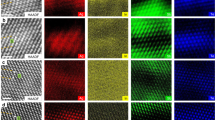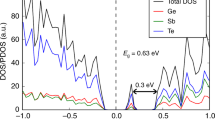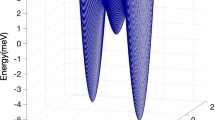Abstract
As the chemical bonds in a covalent semiconductor are independent of long-range order, semiconductors generally have similar local arrangements not only in the crystalline, but also in the amorphous phase. In contrast, the compound Ge2Sb2Te5, which is a prototype phase-change material used in optical and electronic data storage, has been shown to undergo a profound change in local order on amorphization. In this work, ab initio ground state calculations are used to unravel the origin of the local order in the crystalline cubic and the amorphous phase of GeSbTe alloys and the resulting physical properties. Our study shows that this class of materials is characterized by two competing structures with similar energy but different local order and different physical properties. We explain both the local distortions found in the crystalline phase and the occurrence of octahedral and tetrahedral coordination in the amorphous state. Although the atomic rearrangement is most pronounced for the Ge atoms, the strongest change of the electronic states affects the Te states close to the Fermi energy, resulting in a pronounced change of electronic properties such as an increased energy gap.
This is a preview of subscription content, access via your institution
Access options
Subscribe to this journal
Receive 12 print issues and online access
$259.00 per year
only $21.58 per issue
Buy this article
- Purchase on Springer Link
- Instant access to full article PDF
Prices may be subject to local taxes which are calculated during checkout





Similar content being viewed by others
References
Zachariasen, W. The atomic arrangement in glass. J. Am. Chem. Soc. 54, 3841–3851 (1932).
Kolobov, A. et al. Understanding the phase-change mechanism of rewritable optical media. Nature Mater. 3, 703–708 (2004).
Yamada, N. & Matsunaga, T. Structure of laser-crystallized Ge2Sb2+xTe5 sputtered thin films for use in optical memory. J. Appl. Phys. 88, 7020–7028 (2000).
Gaspard, J.-P. & Ceolin, R. Hume-Rothery rule in V-VI compounds. Solid State Commun. 84, 839–842 (1992).
Matsunaga, T. & Yamada, N. Structural investigation of Ge1Sb2Te4: A high-speed phase-change material. Phys. Rev. B 69, 104111 (2004).
Weidenhof, V., Friedrich, I., Ziegler, S. & Wuttig, M. Atomic force microscopy study of laser induced phase transitions in Ge2Sb2Te5 . J. Appl. Phys. 86, 5879–5887 (1999).
Wamwangi, D., Njoroge, W. & Wuttig, M. Crystallization kinetics of Ge4Sb1Te5 films. Thin Solid Films 408, 310–315 (2002).
Kalb, J., Spaepen, F. & Wuttig, M. Calorimetric measurements of phase transformations in thin films of amorphous Te alloys used for optical data storage. J. Appl. Phys. 93, 2389–2393 (2003).
Gygi, F. & Baldereschi, A. Quasiparticle energies in semiconductors: Self-energy correction to the local-density approximation. Phys. Rev. Lett. 62, 2160–2163 (1989).
Ono, I. et al. A study of electronic states of trigonal and amorphous Se using ultraviolet photoemission and inverse-photoemission spectroscopies. J. Phys. Condens. Matter 8, 7249–7261 (1996).
Adler, D., Henisch, H. K. & Mott, S. N. The mechanism of threshold switching in amorphous alloys. Rev. Mod. Phys. 50, 209–220 (1978).
Lankhorst, M., Ketelaars, B. & Wolters, R. Low-cost and nanoscale non-volatile memory concept for future silicon chips. Nature Mater. 4, 347–352 (2005).
Gonze, X. et al. First-principles computation of material properties: the ABINIT software project. Comput. Mater. Sci. 25, 478–492 (2002).
Goedecker, S. Fast radix 2, 3, 4 and 5 kernels for fast Fourier transformations on computers with overlapping multiply-add instructions. SIAM J. Sci. Comput. 18, 1605–1611 (1997).
Payne, M. C., Teter, M. P., Allan, D. C., Arias, T. A. & Joannopoulos, J. D. Iterative minimization techniques for ab initio total-energy calculations: molecular dynamics and conjugate gradients. Rev. Mod. Phys. 64, 1045–1097 (1992).
Gonze, X. Towards a potential-based conjugate gradient algorithm for order-N self-consistent total energy calculations. Phys. Rev. B 54, 4383–4386 (1996).
Fuchs, M. & Scheffler, M. Ab initio pseudopotentials for electronic structure calculations of poly-atomic systems using density-functional theory. Comput. Phys. Commun. 119, 67–98 (1999).
Hamann, D. Generalized norm-conserving pseudopotentials. Phys. Rev. B 40, 2980–2987 (1989).
Perdew, J. P., Burke, K. & Ernzerhof, M. Generalized gradient approximation made simple. Phys. Rev. Lett. 77, 3865–3868 (1996).
Acknowledgements
The authors are grateful for financial support from the Bundesministerium für Wirtschaft und Arbeit (Förderkennzeichen 01 MT 507) and for computer time at the Rechenzentrum of the RWTH Aachen.
Author information
Authors and Affiliations
Corresponding author
Ethics declarations
Competing interests
The authors declare no competing financial interests.
Supplementary information
Supplementary Information
Supplementary information, supplementary figures 1 and 2 and tables 1-3 (PDF 390 kb)
Rights and permissions
About this article
Cite this article
Wełnic, W., Pamungkas, A., Detemple, R. et al. Unravelling the interplay of local structure and physical properties in phase-change materials. Nature Mater 5, 56–62 (2006). https://doi.org/10.1038/nmat1539
Received:
Accepted:
Published:
Issue Date:
DOI: https://doi.org/10.1038/nmat1539
This article is cited by
-
Overview of the Role of Alloying Modifiers on the Performance of Phase Change Memory Materials
Journal of Electronic Materials (2021)
-
CMOS compatible novel integration solution for broad range tunable photodetection using phase-change material based heterostructures
Scientific Reports (2020)
-
Glass-forming ability and thermal stability of Se100−x(Ge2Sb2Te5)x glassy alloys
Journal of Thermal Analysis and Calorimetry (2018)
-
Atomic-scale study of the amorphous-to-crystalline phase transition mechanism in GeTe thin films
Scientific Reports (2017)
-
Picoscale materials engineering
Nature Reviews Materials (2017)



